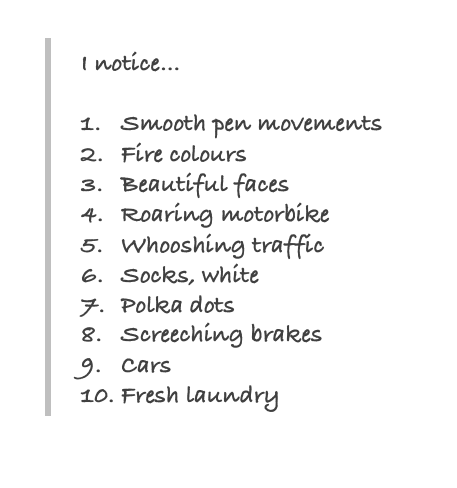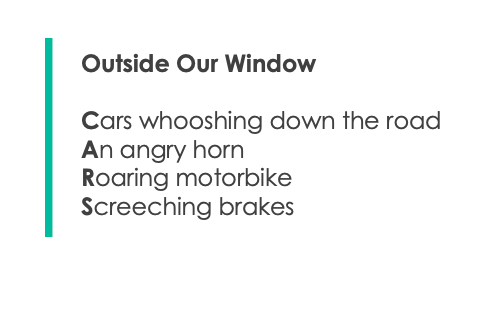Our senses are such powerful tools. Describing the sights, sounds, smells, tastes and textures of a scene can bring a piece of writing to life. These details can help to anchor us in our own lives too. At times when my mind is racing, caught up in worries from the past or anxieties about the future, I find it helps to focus on the physical world. It brings me back to the here and now. That need to feel present and grounded was the inspiration for this simple ‘super senses’ writing activity.
Follow the steps below and by the end you’ll have created your own poem.
Here’s what you do:
1. Make a list of ten things you notice using your senses
2. Choose one word from your list
3. ‘Free flow’ your thoughts & ideas
4. Write your chosen word vertically down the page and fill in each line to create an acrostic* poem
Make a list of ten things you notice using your senses
To create your list of ten things, you can consider exploring the world around you, the world within your body or both. Take in the surrounding environment – what do your senses tell you about it? Focus on your own body – what sensations do you notice?
As you create your list, you might like to seek out unusual things – things that you don’t notice day-to-day. Try creating your list while you’re outside in nature or while in a less familiar setting. You can explore using all five senses – sight, sound, smell, touch, taste – or you can concentrate on just a few of them. Do whatever is right for you.
Choose one word from your list
Look back over the list you have just created. Notice any words or phrases that jump out at you as interesting, funny, curious or significant in some way. Then choose just one word from your list. This will be the subject for your final poem.
‘Free flow’ your thoughts & ideas
Now, spend a few moments thinking about your chosen word and what it means to you. How does it make you feel? What do your senses tell you? (Think about the sights, sounds, smells, tastes and textures the word evokes). Are there any related ideas or phrases that come to mind? Write down anything you can think of about the word you have chosen.

Write your chosen word vertically down the page and fill in each line to create an acrostic poem
The word you chose in the previous step is the topic for your final poem. Whatever you write will relate back to that word. First, take your chosen word and write it vertically down the page. You now have the first letter of each line to get you going. Fill in each line with short phrases or sentences, making sure they relate in some way to your original word. These phrases can be taken from your ‘free flow’ writing or they can be entirely from your imagination.
When you’re finished you will have written an acrostic poem. Read it over. Do you like the way it flows? If there are any lines that don’t feel quite right, have a think about words that could be changed, added or removed. Or you might wish to leave your poem exactly as it is. Congratulations! You have nourished yourself with a creative activity today.

A helping hand…
When writing an acrostic poem, I like to have a dictionary handy. There are times when I look at the letters of my chosen word, written vertically down the page, and my mind goes blank. I can’t think of anything to put with them. Some letters are naturally harder to pair words with than others (‘x’ and ‘z’, for example). Browsing through the pages of a dictionary can make all the difference. I look out for words that ‘feel’ right and go from there.
What next?
Explore my Write to Relax series for more inspiration and ideas.
*What is an acrostic poem?
In an acrostic poem, each line of the poem includes one letter from a chosen word or phrase. When the poem is complete, the individual letters can be read vertically down the page to spell out that word or phrase. Most often, the letters will be at the beginning of each line, as in the example above, but they can also be in the middle or at the end. The chosen word/phrase is linked to the main theme of the poem.

I am going to try this with a twist. I will ask my writers – I teach writing and that’s what I call my students, to think of the a word that describes how they feel right at that moment. Then, I will ask them to add sensory detail that comes with that word. Then we’ll make a word cloud. That way we can easily visualize how we feel at any given day.
Hello, I like your idea of using word clouds. Sounds like a fun way to explore the sensory details surrounding a feeling. Thank you for sharing.